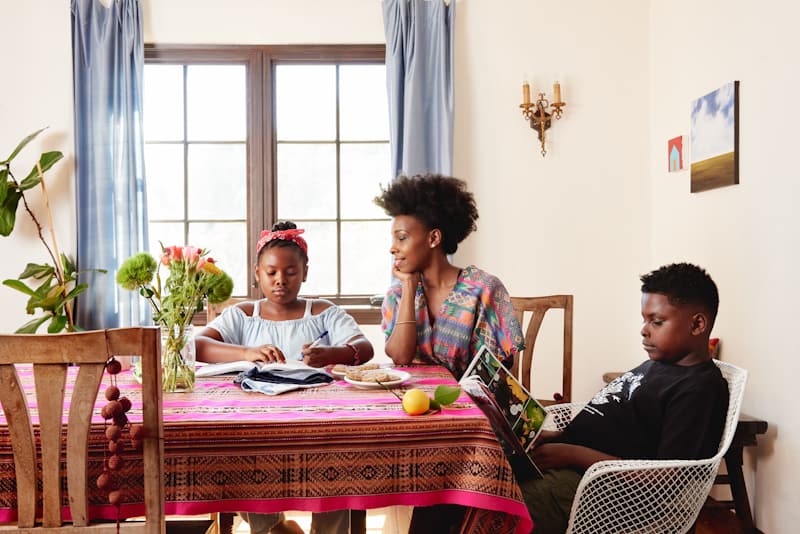
Actually Do-Able Tips For Homeschooling Like A Pro
Written by Erin Feher
Photography by Charmin Roundtree-Baaqee photographed by Maria del Rio
Moms and dads everywhere have just added another job to their résumé: teachers. With schools around the country (and the world) shutting down due to COVID-19, parents are suddenly tasked with teaching their kids themselves. And as most have found out, it’s not an easy job. So, we sat down with Roxanna Elden—she spent eleven years as a public-school teacher, and has been a sought-after speaker on education issues for over a decade—to try and learn a few tricks of the trade. She is the author of See Me After Class: Advice for Teachers by Teachers, used for teacher training all across the country, as well as a brand new fiction book, Adequate Yearly Progress, which follows a diverse group of educators in an urban high school. To help fellow parents during the coronavirus crisis, she answered a few of our most pressing questions about structuring school time at home. Want more? Sign up for her a one-week, sanity-saving email series filled with her most relevant new-teacher advice, ideal for guiding parents who suddenly find themselves rookie teachers.
What’s the best way to structure the day?
“There’s a reason schools have bells: Getting through a 7-hour school day is hard enough with a built-in schedule. Without set transition times, it’s easy to spend the whole day covering one small topic—or rush through everything too quickly and find yourself with a rowdy class and endless free time. For teachers, 30 minutes of unstructured class time can feel like a week and a half. As a stand-in for the school bell, try setting alarms on your phone to break the day into parts, making changes to the schedule as you find your own rhythm. Or, if that feels like too many ringtones in your life, pencil in an hourly weekday schedule and try to stick to it. Another pro tip: make sure you work in a set ‘planning period’—that’s an undisturbed period of time to catch up on the things you have to get done so you can be a better teacher when you’re with the kids.”
How do I plan a lesson?
“There are many ways to structure a lesson plan, but the simplest one is captured by the maxim ‘I do, we do, you do.’ The teacher starts by introducing and actively explaining a concept. Then students practice with the teacher’s help. Then students practice on their own, after which the teacher checks their work to make sure they’ve actually mastered the material. Mistakes can be pointed out in the moment or addressed in the next day’s lesson. The time when students are working independently is crucial for their own understanding; it also functions as a small break for you. Remember that in a class of 20-30 kids, a teacher would not have time to hover over one individual child during every math problem. A parent who’s working remotely or running a corona-panicked household is not expected to, either.”
How do I get my kids to focus?
“Most people of any age have about three hours of the day when they do their best intellectual work. For most of us, that’s in the morning, right after breakfast—hence, the look many teachers get in their eyes when they mention ‘the after-lunch class.’ Try to plan the most demanding, focus-heavy work for the morning hours. Tasks that require less brainpower can wait until the afternoon. Eventually, you’ll reach an hour when everyone in the house is mentally fried. This is also the time when exhausted parents tend to get into power struggles with equally exhausted kids. In many cases, it might be more helpful to accept that no one’s going to focus well on anything.”
What if they are studying something I am unfamiliar with, like a foreign language or advanced math or science concepts?
“If your school district isn’t providing you with online resources, you can still get some sense of what your child should be learning this year by visiting the Common Core State Standards website. You may not know the exact material and how to teach it—everything from calculus to phonics involves some specialized instruction skills. But if you have a basic sense of what your child should be learning, you can dig up ways of keeping them on track. Grade-specific activity workbooks are available anywhere you buy books. You can find documentaries that cover social studies or science topics. And many generous teachers even explain their subjects on YouTube. There’s also a website called TeachersPayTeachers where educators share lesson materials they’ve created for their own classrooms. You can search for lessons by subject, grade level, and Common Core standard. And despite the name of the site, many of the materials are free.”
What about teaching kids of various ages at once?
“In many cases, there are ways of getting kids to creatively work together or having older kids ‘teach’ younger siblings. You don’t need my help with those; you’ll figure them out yourself and they’ll be rewarding and adorable. The real issue comes when you’re essentially teaching two or more different classes at the same time, each with a single student. For those times, it’s important to set rules and routines so kids know what to do when their teacher is busy and cannot help them at that moment. Maybe they wait patiently. Maybe they take out something they can work on independently, or draw a picture. Maybe you set a timer, and nobody is allowed to talk until it goes off. Ideally, this routine does not involve anyone tapping relentlessly on the teacher’s shoulder, hanging on the teacher’s arm, or shrieking for help all at once so the loudest and most insistent screamer gets rewarded.”
There are SO many screen time lessons out there—how do I use them well, versus just sticking my kids in front of them?
“The best screen time has a specific end time and a specific purpose. If your kids are working on a math lesson in an online teaching program, watching a documentary, or even watching a couple of YouTube videos on a topic you’d like them to learn about, you’re probably on the right track. If you’re worried the kids are spending too much time in front of screens, it’s never too late to redraw the lines. But plan that conversation—or any tough conversation—when you’ve got enough mental bandwidth to deal with kids pushing back on the new rules.”
For more at-home learning tips, check out our roundups on the best FREE education sites and apps for kids, great art classes via Instagram, all the online storytimes hosted by some of your favorite children’s authors, and 100 screen-free things to do at home!
Leave a Reply to Cidalia Martins Cancel reply
Share this story





“ Try to plan the most demanding, focus-heavy work for the morning hours…”. To this, I say: Know your child(ren). I struggled mightily with demanding work in the mornings because my best focus time is in the afternoon/evening. Unfortunately, school is one-size-fits-all by necessity.